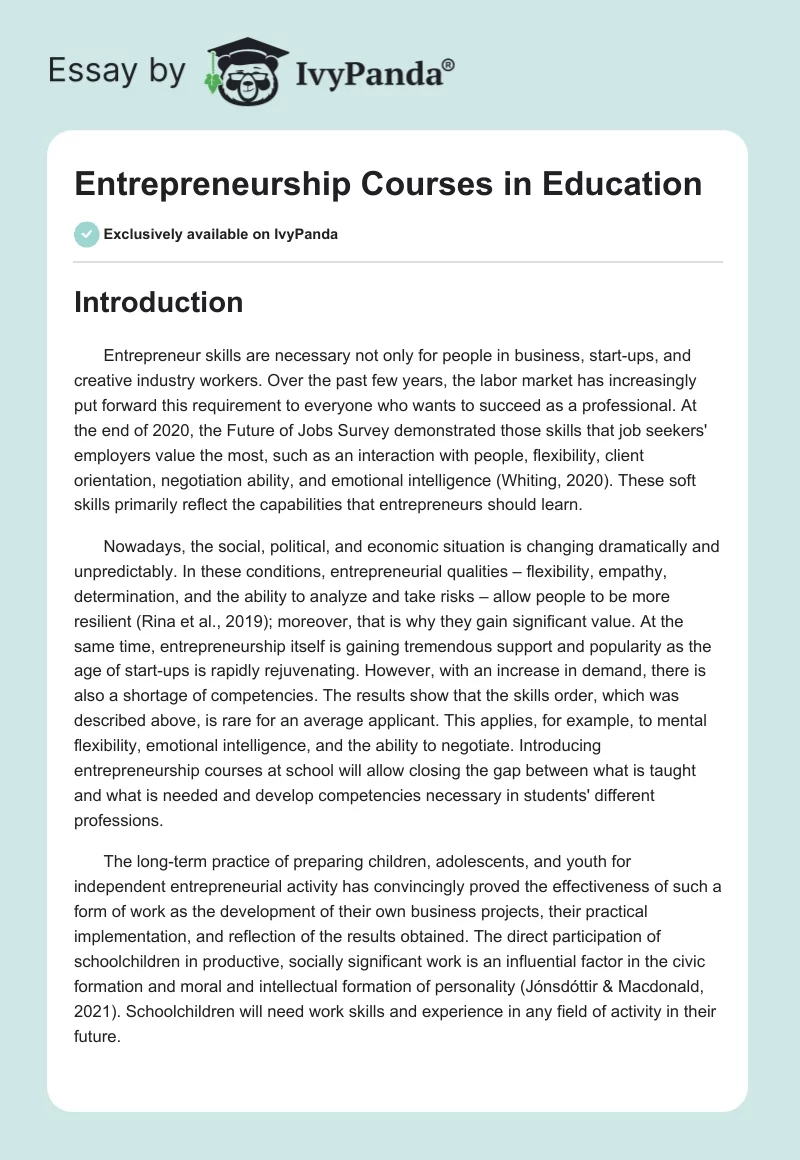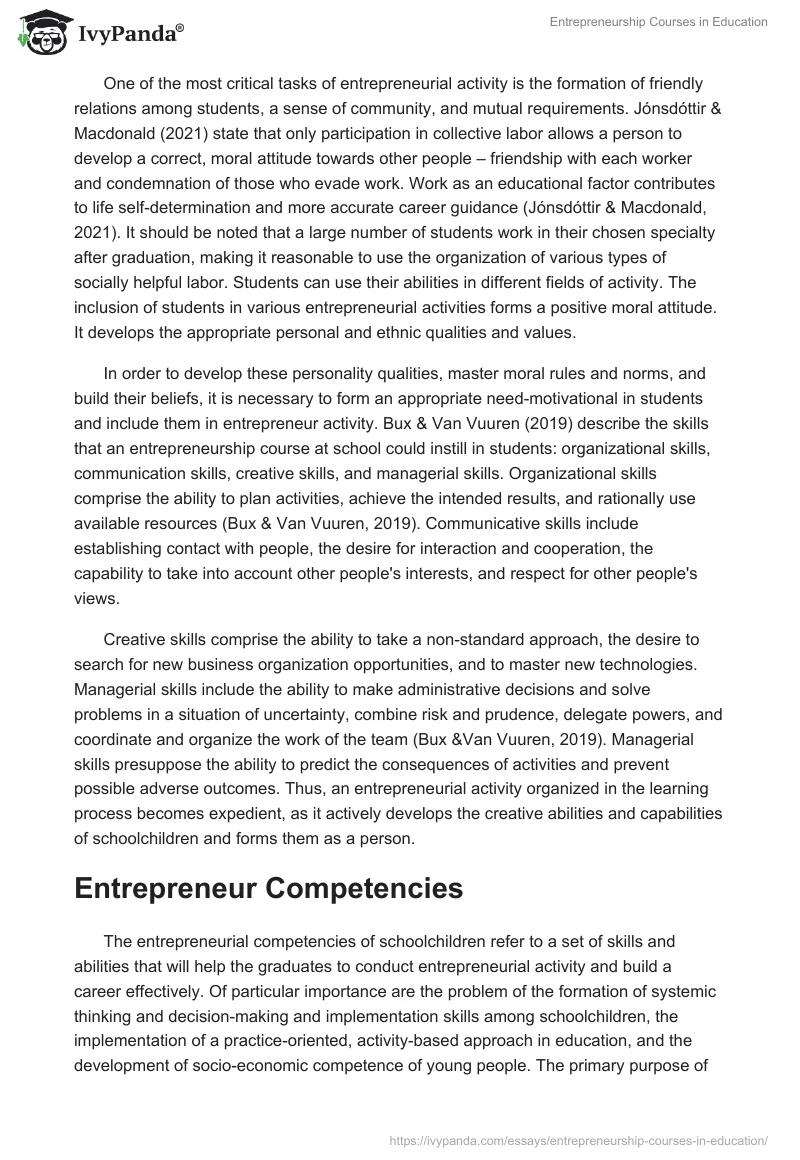Introduction
Entrepreneur skills are necessary not only for people in business, start-ups, and creative industry workers. Over the past few years, the labor market has increasingly put forward this requirement to everyone who wants to succeed as a professional. At the end of 2020, the Future of Jobs Survey demonstrated those skills that job seekers’ employers value the most, such as an interaction with people, flexibility, client orientation, negotiation ability, and emotional intelligence (Whiting, 2020). These soft skills primarily reflect the capabilities that entrepreneurs should learn.
Nowadays, the social, political, and economic situation is changing dramatically and unpredictably. In these conditions, entrepreneurial qualities – flexibility, empathy, determination, and the ability to analyze and take risks – allow people to be more resilient (Rina et al., 2019); moreover, that is why they gain significant value. At the same time, entrepreneurship itself is gaining tremendous support and popularity as the age of start-ups is rapidly rejuvenating. However, with an increase in demand, there is also a shortage of competencies. The results show that the skills order, which was described above, is rare for an average applicant. This applies, for example, to mental flexibility, emotional intelligence, and the ability to negotiate. Introducing entrepreneurship courses at school will allow closing the gap between what is taught and what is needed and develop competencies necessary in students’ different professions.
The long-term practice of preparing children, adolescents, and youth for independent entrepreneurial activity has convincingly proved the effectiveness of such a form of work as the development of their own business projects, their practical implementation, and reflection of the results obtained. The direct participation of schoolchildren in productive, socially significant work is an influential factor in the civic formation and moral and intellectual formation of personality (Jónsdóttir & Macdonald, 2021). Schoolchildren will need work skills and experience in any field of activity in their future.
One of the most critical tasks of entrepreneurial activity is the formation of friendly relations among students, a sense of community, and mutual requirements. Jónsdóttir & Macdonald (2021) state that only participation in collective labor allows a person to develop a correct, moral attitude towards other people – friendship with each worker and condemnation of those who evade work. Work as an educational factor contributes to life self-determination and more accurate career guidance (Jónsdóttir & Macdonald, 2021). It should be noted that a large number of students work in their chosen specialty after graduation, making it reasonable to use the organization of various types of socially helpful labor. Students can use their abilities in different fields of activity. The inclusion of students in various entrepreneurial activities forms a positive moral attitude. It develops the appropriate personal and ethnic qualities and values.
In order to develop these personality qualities, master moral rules and norms, and build their beliefs, it is necessary to form an appropriate need-motivational in students and include them in entrepreneur activity. Bux & Van Vuuren (2019) describe the skills that an entrepreneurship course at school could instill in students: organizational skills, communication skills, creative skills, and managerial skills. Organizational skills comprise the ability to plan activities, achieve the intended results, and rationally use available resources (Bux & Van Vuuren, 2019). Communicative skills include establishing contact with people, the desire for interaction and cooperation, the capability to take into account other people’s interests, and respect for other people’s views.
Creative skills comprise the ability to take a non-standard approach, the desire to search for new business organization opportunities, and to master new technologies. Managerial skills include the ability to make administrative decisions and solve problems in a situation of uncertainty, combine risk and prudence, delegate powers, and coordinate and organize the work of the team (Bux &Van Vuuren, 2019). Managerial skills presuppose the ability to predict the consequences of activities and prevent possible adverse outcomes. Thus, an entrepreneurial activity organized in the learning process becomes expedient, as it actively develops the creative abilities and capabilities of schoolchildren and forms them as a person.
Entrepreneur Competencies
The entrepreneurial competencies of schoolchildren refer to a set of skills and abilities that will help the graduates to conduct entrepreneurial activity and build a career effectively. Of particular importance are the problem of the formation of systemic thinking and decision-making and implementation skills among schoolchildren, the implementation of a practice-oriented, activity-based approach in education, and the development of socio-economic competence of young people. The primary purpose of entrepreneurial education for students is the formation of their prior knowledge of the basics of entrepreneurship and the ability to apply existing knowledge from various fields in their future profession. The modern labor market needs practice-oriented specialists who not only have in-depth knowledge but mainly have the ability and experience to apply them in practice (Shneor et al., 2021). Entrepreneurial competencies are understood as a range of issues in which a person has authority for the successful conduct of entrepreneurial activity; behavior demonstrated in the process of adequate performance of tasks in business.
The formation of these competencies is a complex process that depends on various factors, among which the key ones are: the professional qualities of a teacher of economic disciplines at a school where his role changes from the role of a lecturer to the role of a mentor, the educational system of the institution, psychological and pedagogical support for leadership and business qualities, the ability to work in a team, the desire to learn and develop constantly. The development of entrepreneurial competencies of schoolchildren should be woven into the educational process both in the classroom and in extracurricular activities. Schoolchildren should be taught not only the theoretical foundations of economic knowledge but how to earn and, more importantly, spend money, make a budget, and contribute to the progress (Shneor et al., 2021). The social partnership helps to organize a socially-oriented system of education and upbringing and the development of specific competencies among schoolchildren and young people.
Many countries of the world, especially Europe, have a comprehensive experience. It is a modern local practice of preparing the younger generation to adapt to society from the positions of not only citizenship, the ability to communicate, but also professional orientation, an active life position, skills of independent analysis and solving situations, and the development of entrepreneurial thinking (Rina et al., 2019). The entrepreneur course at school should be aimed at achieving the following goals: the formation of positive motivation; the acquisition by students of knowledge of the basics of entrepreneurial activity; the construction of entrepreneurial skills and abilities; the development of personality qualities such as initiative, self-confidence, and independence.
To develop the necessary competencies at school, practical steps should be taken to organize activities aimed at entrepreneur skills development. Nowadays, there are special programs designed for teenagers 12-16 years old incorporated in the curriculum aimed at developing a project. Jónsdóttir & Macdonald (2018) state that platforms for developing entrepreneurial skills combine theory with practice and give teenagers the opportunity to try to implement their business ideas under the guidance of experienced expert mentors. Teamwork includes business games and team homework. Entertaining lectures are mixed with practical work on the implementation of teenagers’ projects. In addition, program participants are able to visit successful companies and start-ups to see how they function and how they live.
Another project offers information support in such aspects of entrepreneurship as the basics of economics, business and entrepreneurship, and financial literacy for teachers and students of secondary schools. It is assumed that students will be able to put their knowledge into practice in the future and develop their ideas into successful business projects (Jónsdóttir & Macdonald, 2018). The educational and methodological kits are well structured and provide complete theoretical coverage of the issues of professional and career self-determination.
A different initiative comprises the development of innovative projects aimed at solving urgent problems in the economic, social, and environmental spheres. The projects are later evaluated by top managers of leading companies, and the winners receive substantial cash prizes (Jónsdóttir & Macdonald, 2018). The program is aimed at combining education and entrepreneurship and provides an opportunity for the fastest orientation of adolescent leaders in a market environment.
Conclusion
In conclusion, adding entrepreneurship courses to the curriculum will help students acquire the skills required for their vocations and bridge the knowledge gap between what is taught and what is needed. Developing friendly relationships, a feeling of community, and mutual needs among students is one of the most critical responsibilities of entrepreneurial behavior. The efficacy of such work as creating their corporate strategy, actual implementation, and evaluation of the outcomes gained has been decisively demonstrated by the long-term practice of training children, adolescents, and youth for autonomous entrepreneurial activity.
References
Bux, S., & Van Vuuren, J. (2019). The effect of entrepreneurship education programs on the development of self-efficacy, entrepreneurial intention, and predictions for entrepreneurship.Acta Commercii, 19(2), 1-13. Web.
Jónsdóttir, S. R., & Macdonald, M. A. (2018). The feasibility of innovation and entrepreneurial education in middle schools.Journal of Small Business and Enterprise Development. Web.
Rina, L., Murtini, W., & Indriayu, M. (2019). Entrepreneurship education: Is it essential for middle school students? Dinamika Pendidikan, 14(1), 47-59. Web.
Shneor, R., Smith, J. B., Smith, C. G., & Michael Goedecke, J. F. (2021). The differential impact of entrepreneurship education on the entrepreneurial intentions of segments of students.Entrepreneurship Education and Pedagogy, 4(4), 718-739. Web.
Whiting, K. (2020). These are the top 10 job skills of tomorrow–and how long it takes to learn them. In World Economic Forum (Vol. 21). Web.


